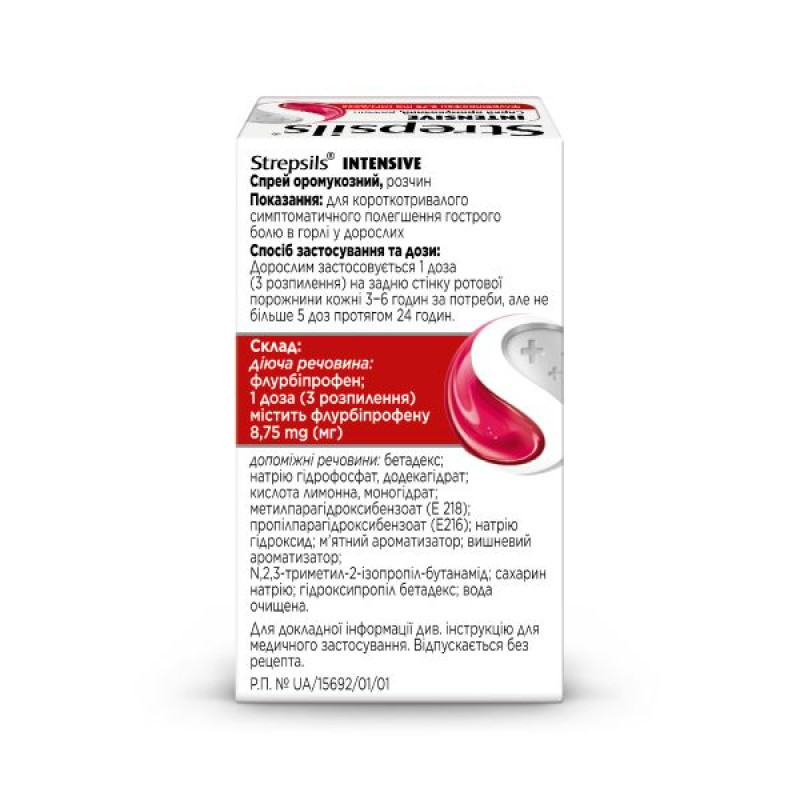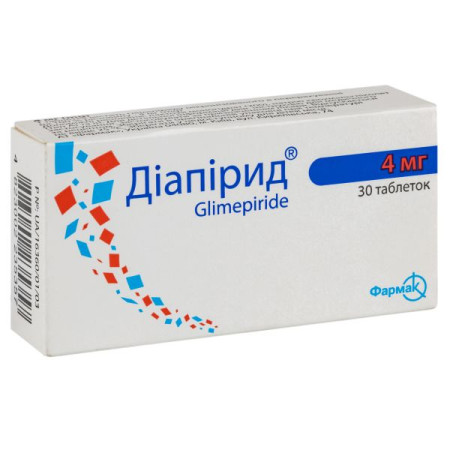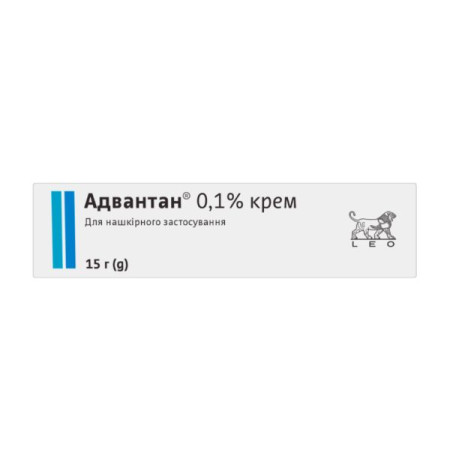Strepsils Intensive oromucosal spray 8.75 mg bottle 15 ml

Instructions for Strepsils Intensive oromucosal spray 8.75 mg bottle 15 ml
Composition
active ingredient: flurbiprofen;
1 dose (3 sprays) contains flurbiprofen 8.75 mg;
Excipients: betadex; sodium hydrogen phosphate, dodecahydrate; citric acid, monohydrate; methyl parahydroxybenzoate (E 218); propyl parahydroxybenzoate (E 216); sodium hydroxide; mint flavor; cherry flavor; N,2,3-trimethyl-2-isopropyl-butanamide; sodium saccharin; hydroxypropyl betadex; purified water.
Dosage form
Oromucosal spray, solution.
Main physicochemical properties: clear solution from colorless to yellowish.
Pharmacotherapeutic group
Drugs used for throat diseases.
Other drugs used for throat diseases. Flurbiprofen.
ATX code R02A X01.
Pharmacological properties
Pharmacodynamics
Flurbiprofen is a nonsteroidal anti-inflammatory drug (NSAID), a propionic acid derivative, which acts by inhibiting prostaglandin synthesis. Flurbiprofen has potent analgesic, antipyretic and anti-inflammatory effects; a single dose dissolved in artificial saliva has been shown to reduce airway mucosal edema in cultured human cells. Studies using whole blood have shown that flurbiprofen is a mixed COX-1/COX-2 inhibitor with some selectivity for COX-1.
Preclinical studies suggest that the R(−) enantiomer of flurbiprofen and related NSAIDs may have effects on the central nervous system; the likely mechanism is inhibition of induced COX-2 at the spinal cord level.
A single dose of flurbiprofen 8.75 mg (three sprays) applied directly to the throat mucosa has been shown to relieve sore throat. In particular, the swollen and inflamed irritated throat areas showed significant changes (AUC) from baseline (mean difference (standard deviation)) of active treatment compared to placebo at 0 to 2 hours (−1.82 (1.35) versus −1.13 (1.14)), 0 to 3 hours (−2.01 (1.405) versus −1.31 (1.233)), and 0 to 6 hours (−2.14 (1.551) versus −1.50 (1.385)). Significant differences in AUC from baseline from 0 to 6 hours compared to placebo were also observed for other pharyngitis symptoms, including pain intensity (−22.50 (17.894) vs. −15.64 (16.413)), difficulty swallowing (−22.50 (18.260) vs. −16.01 (15.451)), throat swelling (−20.97 (18.897) vs. −13.80 (15.565)), and throat pain relief (3.24 (1.456) vs. 2.47 (1.248)). Changes from baseline at individual time points for various pharyngitis characteristics were significant from 5 minutes to 6 hours.
In patients receiving antibiotics for streptococcal infection, relief of pharyngitis symptoms was statistically significantly greater after administration of flurbiprofen 8.75 mg lozenges 7 hours and longer after antibiotic administration. The analgesic effect of flurbiprofen 8.75 mg lozenges is not reduced by the use of antibiotics for the treatment of patients with streptococcal throat infection.
It has also been shown to be effective after multiple doses over 3 days. Strepsils® Intensive, oromucosal spray, solution, is simple and convenient to use. When applied to the inflamed area of the throat, it restores the voice while soothing and softening the throat.
Pharmacokinetics
Absorption.
A single dose of flurbiprofen 8.75 mg (3 sprays) is administered directly into the throat; flurbiprofen is readily absorbed, with detection in the blood within 2–5 minutes; peak plasma concentrations are observed 30 minutes after administration, but the concentration remains at an average low level of 1.6 μg/ml, approximately 4 times lower than in a 50 mg tablet. Strepsils® Intensive is bioequivalent to flurbiprofen 8.75 mg lozenges. Flurbiprofen is absorbed in the oral cavity by passive diffusion. The rate of absorption depends on the dosage form. The same peak concentrations are reached more quickly after the oromucosal spray than after the equivalent dose taken orally.
Distribution.
Flurbiprofen is rapidly distributed in the body and binds to plasma proteins.
Metabolism/excretion.
Flurbiprofen is metabolized by hydroxylation and excreted by the kidneys. The half-life is 3 to 6 hours. Flurbiprofen is excreted in breast milk in only minimal amounts (less than 0.05 μg/ml). Approximately 20-25% of flurbiprofen administered orally is excreted unchanged.
Special groups.
No differences in pharmacokinetic parameters were found in elderly and young adult volunteers after oral administration of flurbiprofen in tablet form.
Indication
For short-term symptomatic relief of acute sore throat in adults.
Contraindication
Hypersensitivity to flurbiprofen or to any of the other components of the drug.
Recurrent peptic ulcer/bleeding in history or in the acute phase (two or more episodes confirmed by characteristic clinical manifestations) and intestinal ulcers.
History of gastrointestinal bleeding or perforation, severe colitis, hemorrhagic or hematopoietic disorders related to previous NSAID therapy.
The last trimester of pregnancy.
Severe heart failure, severe kidney failure, or severe liver failure.
Children's age (up to 18 years).
Interaction with other medicinal products and other types of interactions
The concomitant use of flurbiprofen with:
acetylsalicylic acid, unless acetylsalicylic acid has been prescribed by a doctor in low doses (no more than 75 mg per day), as this may lead to adverse reactions;
other NSAIDs, including selective cyclooxygenase-2 (COX-2) inhibitors, as this increases the risk of side effects (especially gastrointestinal adverse reactions such as ulcers and bleeding).
Flurbiprofen should be used with caution in combination with the following drugs:
Anticoagulants: Nonsteroidal anti-inflammatory drugs may enhance the effects of anticoagulants such as warfarin.
Antihypertensive drugs and diuretics, ACE inhibitors, angiotensin II receptor antagonists. Nonsteroidal anti-inflammatory drugs may reduce the therapeutic effect of these drugs. The risk of nephrotoxicity increases.
Corticosteroids increase the risk of gastrointestinal bleeding or ulcers.
Cardiac glycosides may exacerbate heart failure, reduce glomerular filtration rate and increase plasma glycoside levels. Monitoring of the patient's condition and, if necessary, dose adjustment is recommended.
Antiplatelet and selective serotonin reuptake inhibitors: Increased risk of gastrointestinal bleeding.
Lithium: Increased serum lithium levels may occur. Monitor the patient's condition and adjust the dose if necessary.
Methotrexate: Use of NSAIDs within 24 hours before or after methotrexate administration may lead to increased methotrexate concentrations and increased toxicity.
Cyclosporines: Increased risk of nephrotoxicity.
Mifepristone: NSAIDs should not be taken for 8-12 days after mifepristone administration, as this may reduce the effect of mifepristone.
Tacrolimus: Increased risk of nephrotoxicity.
Zidovudine: Concomitant use of NSAIDs increases the risk of hematological toxicity.
Quinolone antibiotics increase the risk of seizures.
Oral antidiabetic agents: Blood glucose levels may change (increased blood glucose monitoring is recommended).
Phenytoin: Increased plasma levels of phenytoin are possible. Monitoring of the patient's condition and, if necessary, dose adjustment are necessary.
Potassium-sparing diuretics: Hyperkalemia may occur.
Probenecid, sulfinpyrazone. Flurbiprofen is released slowly.
Alcohol: Increased risk of adverse reactions, especially gastrointestinal bleeding.
No interactions have been identified to date between flurbiprofen and tolbutamide or antacids.
Application features
Undesirable effects can be reduced by short-term use of the minimum effective dose necessary to treat symptoms.
Masking the symptoms of the underlying infection.
Epidemiological studies suggest that systemic NSAIDs may mask the symptoms of infection, which may delay the initiation of appropriate treatment and, consequently, worsen the outcome of the infection. This has been observed in bacterial pneumonia and bacterial complications of varicella. If Strepsils® Intensive, oromucosal spray, solution is used in patients with fever or pain associated with an infection, it is recommended to monitor the infection.
Since in isolated cases exacerbation of infectious inflammations (e.g. development of necrotizing fasciitis) has been described in temporal association with the use of systemic NSAIDs, the patient is advised to seek medical advice immediately if signs of bacterial infection or deterioration of the condition occur during treatment with flurbiprofen spray. The need for anti-infective antibiotic therapy should be considered.
In case of purulent bacterial pharyngitis/tonsillitis, the patient is advised to consult a doctor, as the treatment should be reviewed.
Treatment should be carried out for no more than three days.
If symptoms worsen or new symptoms appear, it is recommended to consult a doctor, as treatment may need to be reviewed.
If irritation occurs in the oral cavity, treatment with flurbiprofen should be discontinued.
Elderly patients are at increased risk of adverse reactions to nonsteroidal anti-inflammatory drugs, especially gastrointestinal bleeding or perforation, which can be fatal.
Bronchospasm may occur in patients with bronchial asthma or allergic diseases, as well as in patients with a history of bronchospasm.
Systemic lupus erythematosus and systemic connective tissue diseases increase the risk of aseptic meningitis, but the effect is usually not observed with short-term limited use of drugs such as flurbiprofen in spray form.
Heart, kidney and liver failure.
NSAIDs cause nephrotoxicity in various forms, including interstitial nephritis, nephrotic syndrome, and renal failure. NSAIDs can cause a dose-dependent decrease in prostaglandin production and provoke renal failure. Patients with renal failure, heart failure, liver dysfunction, patients taking diuretics, and elderly patients are at greatest risk, but this effect is usually not observed with short-term limited use of drugs such as flurbiprofen spray.
Liver dysfunction
Mild to moderate hepatic impairment (see sections "Contraindications" and "Adverse Reactions").
Effects on the cardiovascular and cerebrovascular system. Caution should be exercised (after consultation with a doctor) when initiating the use of flurbiprofen-containing products in patients with high blood pressure and/or heart failure, as fluid retention, increased blood pressure and edema have been reported with the use of nonsteroidal anti-inflammatory drugs.
Clinical trial and epidemiological data suggest that the use of some NSAIDs (especially at high doses and over a long period) increases the risk of arterial thrombotic events (e.g. myocardial infarction or stroke). There is insufficient evidence to exclude such a risk with 5 doses per day (1 dose - 3 sprays).
Nervous system symptoms: Prolonged use of analgesics or use not as directed may result in headaches that cannot be treated with increased doses of the drug.
Gastrointestinal effects: NSAIDs should be used with caution in patients with a history of ulcerative colitis or Crohn's disease, as their condition may be aggravated.
Gastrointestinal bleeding, ulceration, or perforation, which can be fatal, has been reported with all NSAIDs, with or without a history of worsening or serious gastrointestinal adverse reactions.
The risk of gastrointestinal bleeding, ulceration and perforation increases with increasing NSAID dose in patients with a history of peptic ulcer disease, particularly if complicated by bleeding or perforation (see section 4.3), and in the elderly, but this effect is usually not observed with short-term, limited use of drugs such as flurbiprofen spray. Patients with a history of gastrointestinal toxicity, particularly the elderly, should report any unusual abdominal symptoms (especially gastrointestinal bleeding) to their physician.
The drug should be used with caution in patients receiving concomitant therapy with medicinal products that increase the risk of peptic ulcer or bleeding, in particular oral corticosteroids, anticoagulants such as warfarin, selective serotonin reuptake inhibitors or antiplatelet agents such as acetylsalicylic acid (see section "Interaction with other medicinal products and other types of interactions").
If a patient receiving flurbiprofen develops bleeding or ulcers in the digestive tract, treatment with the drug should be discontinued.
Hematological effects: Flurbiprofen, like other NSAIDs, may inhibit platelet aggregation and prolong bleeding time. Flurbiprofen spray should be used with caution in patients with a history of abnormal bleeding.
Skin reactions such as exfoliative dermatitis, Stevens-Johnson syndrome and toxic epidermal necrolysis have occurred very rarely. Patients should discontinue treatment with flurbiprofen at the first appearance of rash, mucosal lesions or other signs of hypersensitivity (see section 4.8).
The drug contains methyl parahydroxybenzoate and propyl parahydroxybenzoate, which may cause allergic reactions (possibly delayed).
Use during pregnancy or breastfeeding
Pregnancy.
There are no clinical data on the use of Strepsils® Intensive, oromucosal spray, solution during pregnancy. Even if the systemic exposure is lower compared to oral administration, it is not known whether the systemic exposure achieved after topical administration could be harmful to the embryo/fetus. Flurbiprofen should not be used during the first and second trimester of pregnancy. If used, the dose should be as low as possible and the duration of treatment as short as possible.
The drug is contraindicated during the third trimester of pregnancy, since all prostaglandin synthesis inhibitors can provoke:
in the fetus: cardiopulmonary toxicity (with premature closure of the ductus arteriosus and development of pulmonary hypertension), impaired renal function, oligohydramnios or polyhydramnios progressing to renal failure;
in the mother and newborn: prolonged bleeding due to the antiaggregant effect, which may occur even at very low doses; inhibition of uterine muscle contractions, leading to delayed or prolonged labor.
Breast-feeding.
Small amounts of flurbiprofen have been detected in breast milk, but no adverse effects of flurbiprofen on breastfed infants have been observed. Use of the drug should be avoided during breast-feeding.
Reproductive function.
There is some evidence that drugs that inhibit cyclooxygenase/prostaglandin synthesis can negatively affect female reproductive function, specifically ovulation. Reproductive function is restored after treatment is discontinued.
Ability to influence reaction speed when driving vehicles or other mechanisms
Dizziness, drowsiness, fatigue, and visual disturbances may occur when using NSAIDs. If this side effect occurs, driving or operating machinery is not recommended.
Method of administration and doses
For oromucosal use. For short-term use only.
Adults apply 1 dose (3 sprays) to the back of the mouth every 3–6 hours as needed, but not more than 5 doses in 24 hours.
Do not inhale while spraying.
It is not recommended to use the drug for more than 3 days.
Before first use, you must activate the sprayer. To do this, turn the nozzle away from you and press the cap at least four times until the spray starts to spray in the form of a transparent, uniform cloud. This will allow the medicine to enter the sprayer and the spray will be ready for use.
Before using each subsequent dose, turn the nozzle away from you, press the cap at least once and make sure that the spray is sprayed in the form of a transparent, uniform cloud. Each time before use, it is necessary to check the spray in the form of a uniform cloud.
Elderly patients should be treated with the lowest effective dose for the shortest possible time. Elderly patients are at increased risk of serious adverse reactions.
Use the lowest effective dose necessary to control symptoms for the shortest period of time (see section "Special instructions").
Children
The safety and efficacy of Strepsils® Intensive in children (under 18 years of age) have not been established.
Overdose
Symptoms. Most patients who have taken clinically significant amounts of nonsteroidal anti-inflammatory drugs may experience only nausea, vomiting, epigastric pain or, very rarely, diarrhea. Tinnitus, headache and gastrointestinal bleeding may also occur. In more severe poisoning, toxic lesions of the central nervous system in the form of drowsiness are possible, sometimes - agitation, visual impairment, disorientation or coma. Sometimes patients experience convulsions. In severe poisoning, metabolic acidosis may occur and prothrombin time may be prolonged due to the effect on blood clotting factors. Acute renal failure and liver damage may occur. In patients with bronchial asthma, exacerbation of the course of the disease is possible.
Treatment. Treatment may be symptomatic and supportive, and may include airway clearance, monitoring of cardiac and vital signs until stable. Oral administration of activated charcoal or gastric lavage is recommended, with correction of serum electrolytes if necessary, if the patient presents within 1 hour of ingestion of a potentially toxic amount. Intravenous diazepam or lorazepam should be used in cases of frequent or prolonged seizures. Bronchodilators should be used in cases of bronchial asthma. There is no specific antidote to flurbiprofen.
Side effects
Cases of hypersensitivity reactions to NSAIDs have been reported, namely:
nonspecific allergic reactions and anaphylaxis;
airway reactivity, e.g. bronchial asthma, exacerbation of bronchial asthma, bronchospasm, shortness of breath;
Events such as edema, hypertension, and heart failure have been reported in association with NSAID treatment. There is insufficient data to exclude such a risk with flurbiprofen oral spray, solution.
The following adverse reactions have been observed during short-term use of flurbiprofen. The frequency of adverse reactions is defined as follows: very common (> 1/10), common (> 1/100 to < 1/10), uncommon (> 1/1,000 to < 1/100), rare (> 1/10,000 to < 1/1,000), very rare (< 1/10,000), not known (cannot be estimated from the available data).
From the blood and lymphatic system:
not known: anemia, thrombocytopenia.
From the cardiovascular and cerebrovascular system:
not known: edema, hypertension and heart failure.
From the nervous system:
common: dizziness, headache, paresthesia (tingling sensation, numbness, itching);
uncommon: drowsiness.
From the respiratory system, chest organs and mediastinum:
common: throat irritation;
uncommon: exacerbation of bronchial asthma and bronchospasm, dyspnea, wheezing, oropharyngeal blisters, pharyngeal hypoesthesia.
From the gastrointestinal tract:
common: diarrhea, throat ulcers, nausea, oral pain, oral paresthesia, oropharyngeal pain, oral discomfort (feeling of warmth, burning or tingling in the mouth);
Infrequent: abdominal distension, abdominal pain, constipation, dry mouth, dyspepsia, flatulence, burning mouth syndrome, dysgeusia, oral dysesthesia, vomiting.
From the skin and subcutaneous tissue:
infrequently: various skin rashes, itching;
not known: severe skin reactions such as bullous reactions, including Stevens-Johnson syndrome and toxic epidermal necrolysis.
General disorders and local reactions:
uncommon: fever, pain.
On the part of the immune system:
Rare: anaphylactic reactions.
Mental disorders:
uncommon: insomnia.
From the liver and biliary tract:
Not known: hepatitis.
If adverse reactions occur, treatment should be discontinued and a doctor should be consulted.
Expiration date
2 years.
Storage conditions
Store at a temperature not exceeding 25 ° C. Keep out of the reach of children.
After first opening the bottle, store for no more than 6 months.
Do not refrigerate or freeze.
Packaging
15 ml in a bottle, 1 bottle in a cardboard box.
Vacation category
Without a prescription.
Producer
Reckitt Benckiser Healthcare International Limited.
Location of the manufacturer and its address of place of business
Nottingham site, Thane Road, Nottingham, NG90 2DB, United Kingdom
There are no reviews for this product.
There are no reviews for this product, be the first to leave your review.
No questions about this product, be the first and ask your question.



























